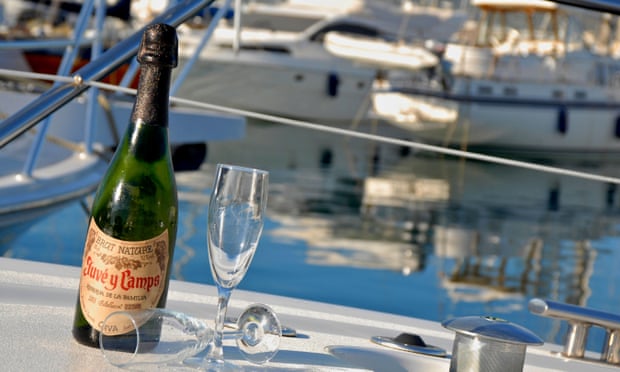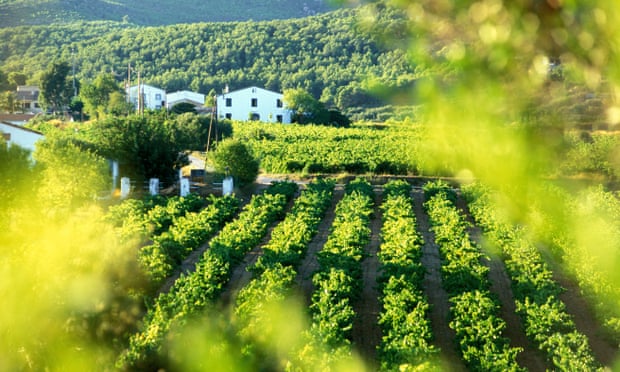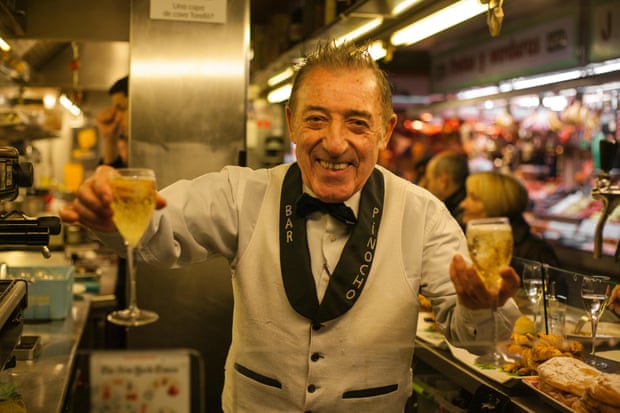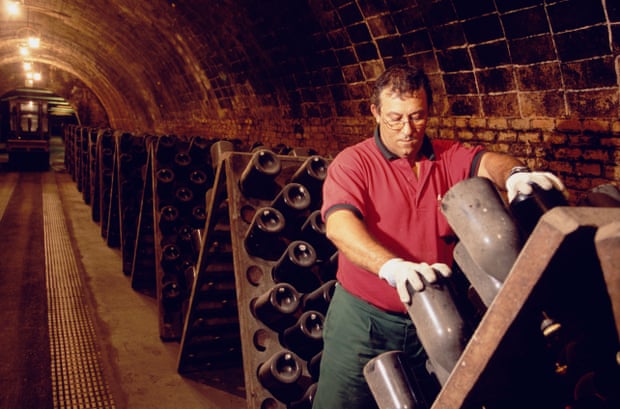 |
| A bottle of Cava on a yacht in Ibiza. High-quality cavas feature regularly on upmarket hotel and restaurant menus in Spain. Photograph: Alamy Stock Photo |
Cava, ally of thrifty bucks fizz fans, bitter adversary of prosecco and a drink long viewed as champagne’s poor relation, is looking to reclaim its status as one of the world’s greatest sparkling wines with a high-end category intended to take the fight firmly to the French.
The wine, which is made in the same way as champagne, has proved a huge success for Spain over recent decades, with producers churning out almost 250m bottles a year, more than half of which are exported to 130 countries.
But many in the sector fear quality has been sacrificed to quantity and that cava is now seen more as a cheap supermarket staple than as a premium product that can comfortably go cork-to-cork with champagne.
With that in mind, the Cava Regulatory Council decided to establish a new category – cava de paraje calificado, or single-vineyard cava – to showcase the very best the wine has to offer.
The classification is still awaiting final sign-off from Spain’s agriculture ministry, but the first bottles are expected to appear on the shelves soon, priced somewhere between €40 (£34) and €100.
To qualify for the category, cava must conform to a series of requirements, such as being made on the estate, coming from vines that are at least 10 years old and spending at least three years ageing in the bottle.
 |
| A vineyard in the Penedès wine region of Catalonia, one of the cava-producing areas of Spain. Photograph: Alamy Stock Photo |
Pedro Bonet, president of the regulatory council, says one of his most pressing priorities on assuming the job four years ago was to rescue cava’s flat image. He and his colleagues pursued the idea of pushing the premium and super-premium sector, which accounts for around 13% of total production.
The aim, he says, is to get consumers to give cava the same level of respect they unthinkingly afford bordeaux or champagne.
“Why does champagne have such a fantastic image when so much of it is sold cheaply?” he says. “About 180m bottles of cheap champagne are sold each year but when people see champagne, all they see is champagne.
“And that’s terrific, isn’t it? Over the past two centuries, champagne has established its place in the wine market through its big brands. Cava, on the other hand, has established itself through the mid-range and through modern distribution, which is why it’s image isn’t premium.”
In Spain, he says, things are a little different, with high-quality cavas featuring regularly on menus in upmarket hotels and restaurants and bottles stacked in the windows of delicatessens.
 |
| Bartender Juanito holding two cava glasses in the Boqueria Market in Barcelona. Photograph: Alamy |
Bonet hopes that the new category will appeal to cosmopolitan drinkers 40 and over; or, as he puts it, “a consumer who’s open to trying the best that different places have to offer”.
Sarah Jane Evans, master of wine, co-chairman of the Decanter world wine awards and an expert on Spanish wine, applauds cava producers for trying to adapt to a changing market. Two years ago, UK sales of prosecco overtook those of champagne for the first time.
“Cava has for years been a really wonderful product for producers because it’s just sold and sold,” she says. “Until very recently it’s been a magical item that was a must-buy. In the UK, if you wanted an alternative to champagne for, say, a cheaper version of buck’s fizz or for Christmas Day, it was cava.”
And then came the Italian interloper. But, unlike its French and Spanish cousins which are entirely bottle-fermented, most proseccos undergo a secondary fermentation in large tanks.
 |
| Cava is made in the same way as champagne. Photograph: Alamy |
Bonet willingly recognises prosecco’s huge international gains – “[it’s] a really well distributed phenomenon, which appeals to a sector of the population who drink occasionally and who want products that tend towards the sweet” – but is adamant that champagne remains the ultimate benchmark against which the new cavas will be tested.
“When people talk to me about prosecco, I always ask them to name me a brand. Then I ask how many cavas can they name? Three or four? And when it comes to champagne, it’s more than that. Even though more prosecco is sold in the UK than champagne, no one knows the brands.”
Evans says that while many retailers and sommeliers in the UK are more attracted to champagne – and, increasingly, English sparkling wines – the best cava is a more than worthy rival.
But the inevitable question remains: why pay champagne prices for cava?
“Because it’s carefully made – often handmade – from a special vineyard and it will have a very individual taste of the place where it comes from,” she says.
“I think we’re all looking, at that price, for memorable wines. And in that category, you can find some very memorable wines.”
Comment of / Comentario de Wines Inform Assessors:
Very interesting to follow the numerous comments that appeared on this article (see link to The Guardian)
Muy interesante seguir los numerosos comentarios que aparecieron sobre este artículo (ver link a The Guardian)
Origin information: The Guardian








No hay comentarios:
Publicar un comentario